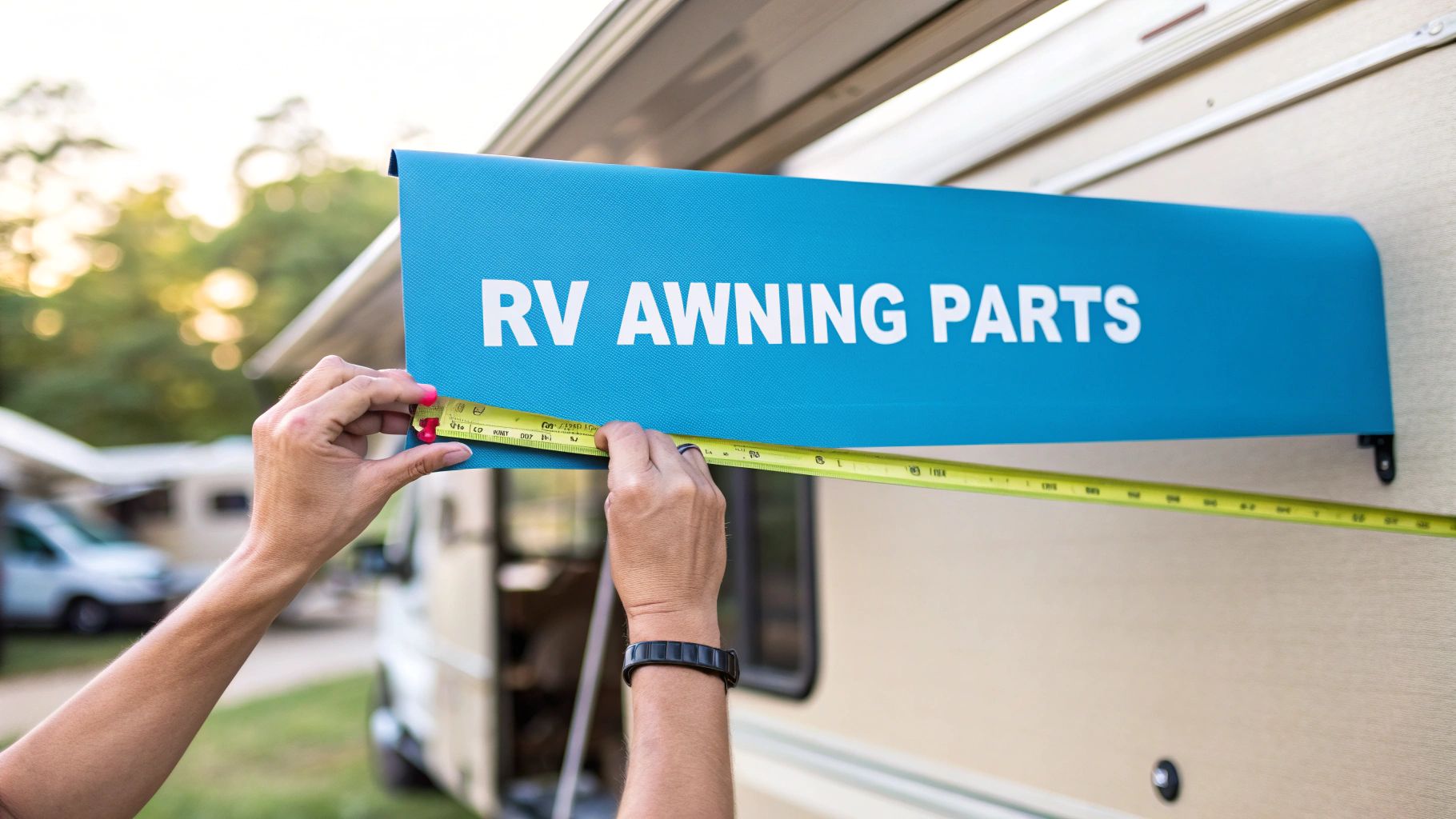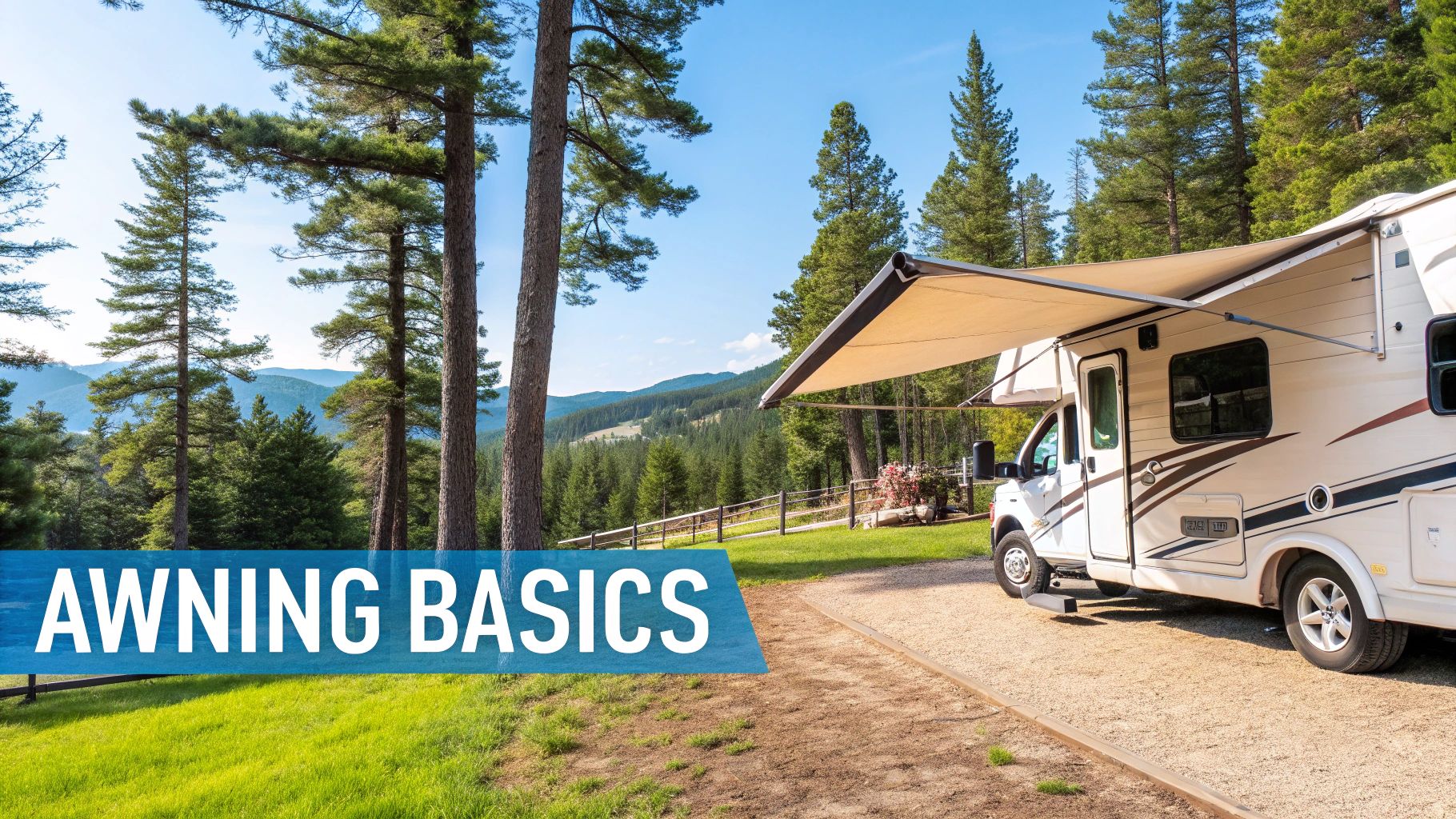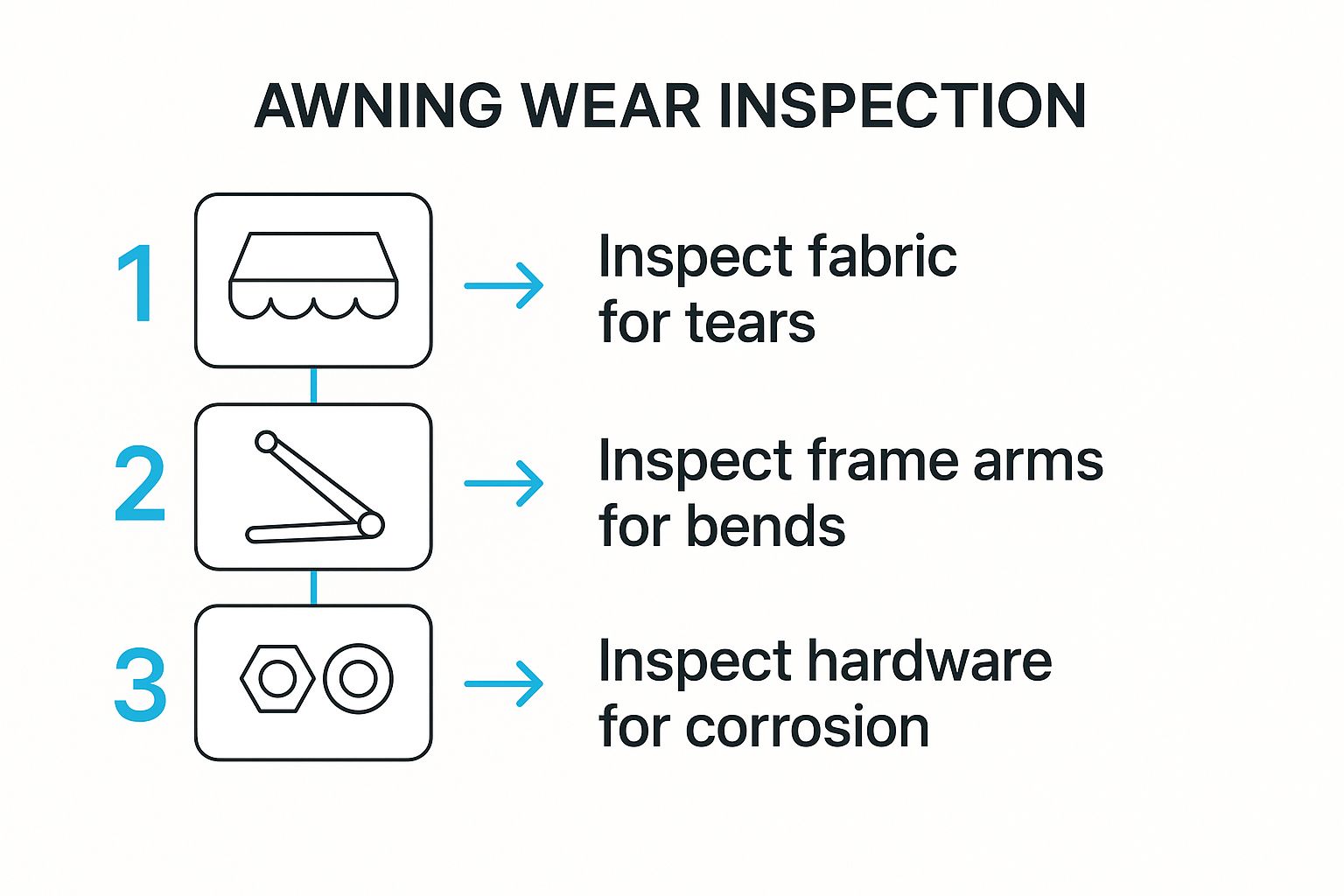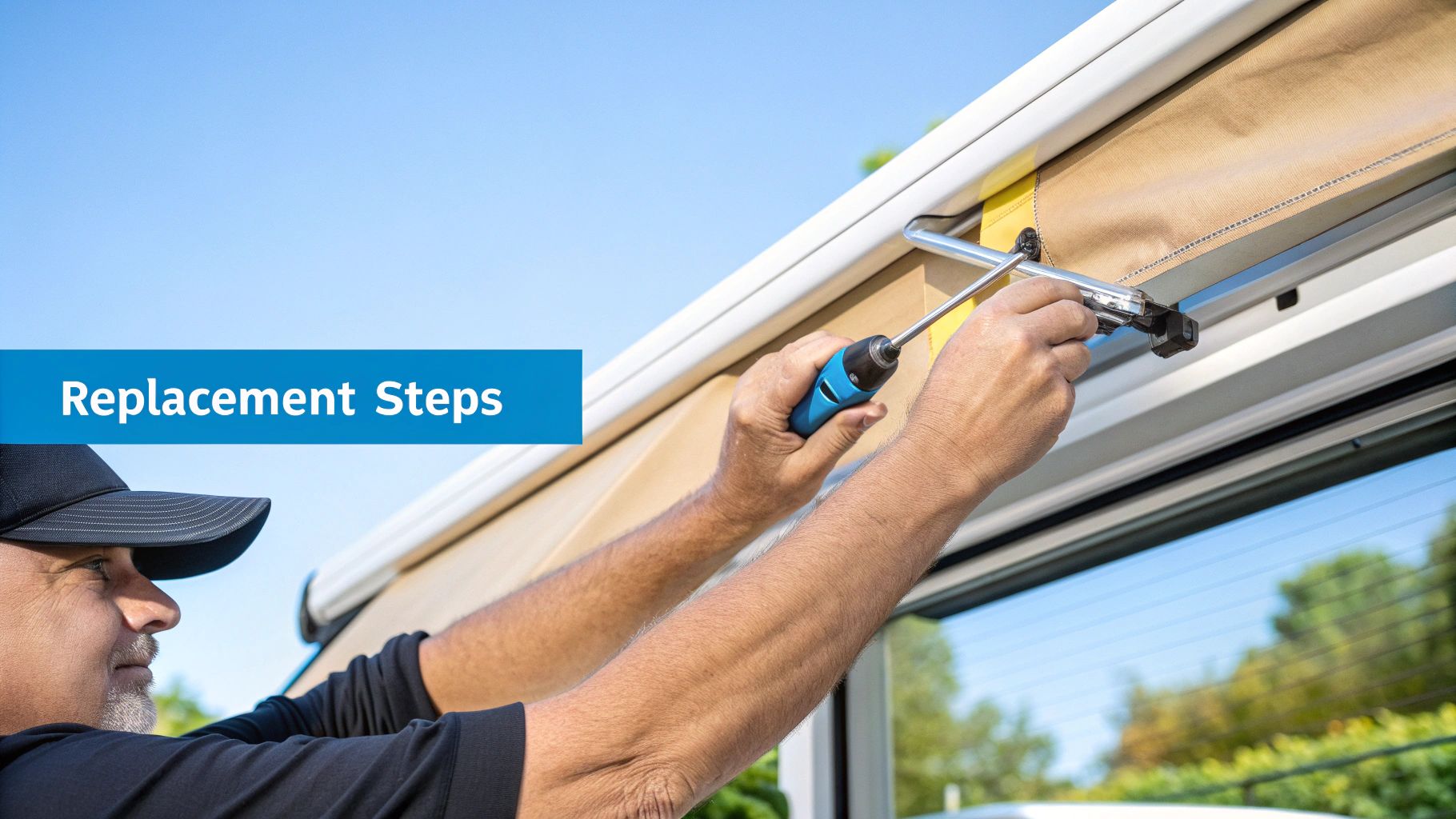

· By James
A Practical Guide to RV Awning Replacement Parts
Before you even think about buying RV awning replacement parts, you have to play detective. Getting the diagnosis right from the start is the most important step. The usual suspects are torn fabric or a motor that's given up, but I've also seen plenty of bent arms or busted roller tubes causing the headache. A quick but thorough inspection will point you to the exact failed component, saving you from shelling out for a full hardware kit when all you really needed was a new roll of fabric.
Is Your RV Awning Beyond Repair?

The first step in any RV repair is getting a clear picture of what you're up against. It’s how you move from feeling frustrated to having a solid action plan. Some problems are glaringly obvious, but others are more subtle. A methodical check is your best defense against wasting time and money.
Put on your detective hat. Is the fabric just a bit stained with mildew, or is there a serious tear that’s catching the wind like a sail? You might be able to patch a small rip, but a big, sun-rotted gash is a clear sign that it's time for a full fabric replacement.
Assessing the Hardware and Motor
Next up, let's look at the mechanical guts of the awning. Extend and retract it a few times, paying close attention. Listen for strange noises and watch how everything moves.
Does the motor on your power awning just whine and struggle without actually moving the fabric? That's a huge red flag pointing straight to a motor or electrical problem.
For any type of awning, give the support arms a good once-over. A slight bend, maybe from a little run-in with a low-hanging tree branch, can be enough to stop the awning from closing flush against your RV. It’s these subtle bends that people often overlook, but they're a common source of trouble.
Once you can confidently say whether the problem is the fabric, the arms, the roller tube, or the motor, you'll know exactly which RV awning replacement parts to look for. This simple diagnostic step is hands-down the best way to keep repair costs under control.
Making the Final Call
Before you start adding parts to your shopping cart, you have to be honest about the extent of the damage. If you're a full-timer, a reliable awning isn't just a luxury, it's essential gear. Our guide on https://swiftnetwifi.com/blogs/news/how-to-live-in-an-rv-full-time really drives home the importance of keeping your rig in top shape.
When you're looking at multiple damaged components, you have to weigh the cost of buying individual parts against a whole new assembly. The same logic applies when you're diagnosing whether a component is beyond repair in other systems. A clear, honest assessment right now ensures you make the right investment for your travels down the road.
How to Measure and Identify Your Awning Parts
When you’re ordering RV awning replacement parts, getting it right the first time boils down to two things: a good measurement and the right model number. Guessing is a surefire way to end up with a massive headache trying to return a heavy, oversized part that just won't fit.
Let's walk through exactly how to get this right so you can get back on the road.
Nailing the Awning Fabric Measurement
The single most common part people need to replace is the awning fabric, and this is where the first mistake usually happens. Whatever you do, do not measure the old fabric or the roller tube. It seems logical, but it will lead you astray.
The industry-standard measurement for awning fabric is taken from the center of one awning arm to the center of the other. It’s that simple. If you measure 18 feet from the center of one arm to the center of the other, you order an 18-foot awning fabric. The actual fabric that arrives will be a little smaller than 18 feet, and that's by design—it's made to fit perfectly within the hardware you just measured.
I’ve seen this happen a dozen times: someone measures their roller tube, orders a fabric that matches, and it ends up being too wide. It either bunches up or just won't install correctly. Always, always measure from the center of the arm assemblies.
Finding the Manufacturer's Model Number
Your awning's model number is its fingerprint. It's the key to getting a perfect match for almost any part, whether it's a motor, an end cap, or a support arm. Most of the time, manufacturers stick this info on a label somewhere on the awning assembly.
Here’s where to look:
- On the Roller Tube: The most common spot is a sticker on the metal roller tube itself. You'll probably have to unroll the awning completely to find it.
- Inside the Housing: If you have a cassette-style awning, check the main housing unit that’s attached to the RV.
But what if you’ve got an older Dometic or Carefree of Colorado awning and that sticker peeled off years ago? Don't panic. You'll have to play detective with a tape measure and your phone's camera. Measure things like the roller tube diameter and arm length, then take some clear pictures of the hardware. Any reputable supplier can usually help you identify the model with those details.
Taking a methodical approach to gathering this info is critical for finding the right rv awning replacement parts. Before you even pull out the tape measure, it's a good idea to give your whole awning a quick once-over for any other signs of wear.

This quick visual check helps you spot the most common failure points, so you don’t end up ordering fabric when what you really needed was a new support arm.
To make sure you get all the right numbers before you start shopping, here’s a quick reference table. It covers the most common parts you'll need to measure and points out some easy-to-make mistakes.
| Component | How to Measure | Common Mistake to Avoid |
|---|---|---|
| Awning Fabric | Measure from the center of one awning arm to the center of the other arm. | Measuring the old fabric directly or the length of the roller tube. |
| Roller Tube | Measure the exact length of the tube from end cap to end cap. | Guessing the length based on the fabric size. Tubes can vary. |
| Support Arms | Measure the full extended length of the arm, from the top pivot to the bottom bracket. | Measuring only a section of the arm or when it's retracted. |
| Gas Struts | Measure the extended length from the center of one mounting point to the center of the other. | Forgetting to check the force rating (usually printed on the strut) in pounds or newtons. |
| End Caps | Note the roller tube diameter and the shape. Take a clear photo for reference. | Assuming all end caps for a brand are the same. They change with the model. |
Having this table handy will save you a ton of guesswork.
The demand for these parts is no small thing. The RV awning market was a USD 1.2 billion industry and is on track to more than double by 2033. Most RVers find themselves replacing their fabric every 3–5 years due to sun and weather damage, which keeps the parts market humming. If you want to dive deeper, you can check out more stats on the RV awning market growth on Verified Market Reports.
Taking a few extra minutes to measure properly ensures you get the right component from this huge market, saving you from return shipping nightmares and getting you back to relaxing under your awning.
Choosing the Best Replacement Fabric and Materials

The fabric is the face of your awning. It’s what gives you shade, adds a splash of style to your rig, and takes a beating from the weather day in and day out. When the time comes for a new one, the material you pick is going to make a huge difference in your comfort and how long the awning lasts.
Your main choices are going to be vinyl and acrylic. At first glance, they might seem pretty similar, but how they perform in the real world couldn't be more different. The best one for you really boils down to how and where you like to camp.
Vinyl Versus Acrylic Fabrics
Vinyl is the workhorse for a lot of RVers, and for good reason: it's 100% waterproof. If you find yourself camping in rainy spots like the Pacific Northwest, a vinyl awning is your best bet for keeping your outdoor living space bone dry. It’s also a breeze to clean—most grime comes off with a quick wipe-down.
But vinyl isn't perfect. Because it doesn't breathe, it can trap heat and moisture. On a blazing hot day, you can literally feel the heat radiating down from the awning. And if you roll it up while it's still damp, you're basically inviting mildew to the party.
Acrylic, on the other hand, is a woven fabric, which means it’s breathable. Air and moisture can pass right through it. This makes the space underneath feel noticeably cooler and helps the fabric dry out fast, cutting down the risk of mold and mildew.
That breathability does come with a trade-off, though. Acrylic is water-resistant, not waterproof. It’ll shed water just fine during a light sprinkle, but in a real downpour, you might start to feel a fine mist coming through.
Ultimately, your camping style should be the deciding factor. Heading to hot, dry places like Arizona or Utah? The breathable acrylic is a no-brainer for staying cool. Spending your time in humid, rainy environments? You’ll be glad you have the waterproof protection of vinyl.
Universal vs. OEM Awning Fabric
The next decision you'll face is whether to get a universal fabric or spring for one from the original equipment manufacturer (OEM). Universal fabrics are a great way to save some cash, as they're designed to fit a wide range of standard awning models. For a basic, straight-sided patio awning, a good-quality universal fabric is often a fantastic, budget-friendly option.
However, if you're dealing with a more specialized awning—like a slide-out topper or a window awning with very specific dimensions—it’s usually worth spending the extra money on an OEM fabric. You're guaranteed a perfect fit for your hardware, which takes all the guesswork out of the installation.
It’s also worth noting that the whole rv awning replacement parts market is seeing some cool advancements. We're seeing more lightweight, high-tech, UV-resistant fabrics that are designed to last longer between replacements. They might cost a bit more upfront, but as a report on the RV awnings market by Wise Guy Reports highlights, innovations in materials are a major trend. Investing in a better fabric today can really pay off in the long run.
When your awning's problems are more than skin deep—or fabric deep, in this case—it's time to get your hands on the hardware. Swapping out mechanical or motorized rv awning replacement parts can sound a little daunting, but for a confident DIYer, it's a totally manageable job if you're careful and methodical.
One of the most common hardware failures I see is a bent support arm. They're often the first casualty of a surprise wind gust or a misjudged encounter with a low-hanging tree branch. The replacement process itself is pretty simple, but it comes with a massive safety warning: you absolutely have to deal with the spring tension inside the roller tube.
Here’s a trick I learned from a seasoned RVer: grab several heavy-duty zip ties and clamp that roller tube down before you even think about unbolting a single thing. This simple step keeps that powerful spring from uncoiling on you, which can cause a really nasty injury. Once it’s secured, you can go ahead and safely swap out the old arm for the new one.
Tackling a Power Awning Motor Replacement
If you've got a power awning, a dead motor can put a real damper on your outdoor setup. Replacing one is mostly basic 12-volt electrical work, and your first move, always, is to kill the power. Make sure you flip the 12V disconnect switch or, better yet, unhook your RV's battery. You don't want any sparks flying.
With the power safely off, you can get to the motor, which is usually tucked inside one of the end caps of the roller tube. You'll need to carefully unplug its wiring harness, unbolt the old motor assembly, and just slide it out. Putting the new one in is the exact same process in reverse: slide it into place, tighten the bolts, and plug the wiring back in.
My best advice here? Take a quick photo with your phone before you unplug the old motor. It's a foolproof way to remember which wire goes where. Getting it wrong won't just mean it doesn't work—you could fry your brand-new motor.
Power awnings have become incredibly popular, which is good news for us because replacement parts are easier to find than ever. The RV power awning market was valued at USD 250 million and is expected to climb to USD 400 million by 2033. This boom is largely because components like motors and sensors just don't last as long as the awning fabric itself. If you're interested in the market side of things, you can read the full research about the RV awnings market for more details.
Considering an Upgrade from Manual to Power
If you're already tearing into your manual awning to replace a major part, you might want to pause and think about an upgrade. Converting a manual setup to a power system is a popular project these days, and for good reason.
The conversion usually means swapping both support arms for motorized versions and running a new 12V wire from your RV's power center. You can buy kits that have everything you need to get the job done:
- Motorized Arms: These new arms house the motor and all the power mechanisms.
- Wiring Harness: Connects the motors to your RV's 12-volt system.
- Control Switch: A new switch for inside your rig to extend and retract the awning with a button press.
This upgrade completely gets rid of the manual cranking and adds a serious dose of convenience to your campsite. It's definitely a bigger project than just replacing a broken arm, but it's an investment in ease and comfort that many RVers find is well worth the weekend's work.
Where to Find Your RV Awning Replacement Parts

Alright, you've got your measurements and, hopefully, a part number scribbled down. Now comes the treasure hunt. The market for rv awning replacement parts is surprisingly big, which is both good and bad. You have plenty of choices, but you’ll need to figure out what matters most to you: cost, speed, or getting a little expert advice along the way.
Your first thought might be to go straight to the source. Contacting a manufacturer like Dometic or Carefree of Colorado directly is often the most foolproof method. It's the best way to guarantee a perfect fit, especially if you’re dealing with a newer rig or a complex powered awning system. You're buying the exact component that was installed at the factory, so there’s zero guesswork about compatibility.
Exploring Online Marketplaces
Of course, the internet is overflowing with options. Big players like Amazon and specialty RV sites like eTrailer have a massive selection and some pretty competitive prices. It's easy to shop around, compare different brands, and even find universal parts that can save you a good chunk of change.
But that endless selection can be a double-edged sword. It’s easy to get overwhelmed. My advice? Read the customer reviews like a hawk and always, always double-check the seller's return policy. This is critical for big, awkward items like support arms or roller tubes. The cost to ship something like that back can completely wipe out any money you thought you saved.
When you're shopping online, treat the part number like a password—it must be an exact match. Cross-reference the number from your awning with the product listing to avoid any expensive mix-ups. This simple check is your best defense against ordering the wrong component.
The Value of Local Dealerships and RV Shops
Don't write off your local RV dealership or service center just yet. Yes, their prices might be a little higher, but the expertise you get in return can be priceless. There’s a huge advantage to being able to walk in with your broken part, talk to a real person who knows their stuff, and physically compare the old with the new before you hand over your credit card.
That face-to-face confirmation is a lifesaver, especially for older RVs where part numbers have long since faded away. Plus, you’re keeping a local business in business—one that serves fellow RVers. A great way to find nearby shops is with a tool like the AllStays RV directory; it can point you to reputable dealerships and service centers in your area: https://swiftnetwifi.com/pages/allstays-rv
The growth of online retail has made it easier than ever for RVers to tackle these repairs themselves. You can find everything from tiny brackets to full roller tubes and fancy LED light kits with a few clicks. This DIY trend has really pushed the aftermarket forward.
And if you’re hunting for a really obscure part, turn to the community. RV forums and Facebook owner groups are absolute goldmines. Fellow travelers are usually more than happy to share links to good sellers or help you identify that weird end cap for a vintage model. Sometimes, the best route is a specialized online store that carries a general collection of replacement parts, where you might just stumble upon exactly what you need.
Got Questions About Your RV Awning Repair?
Finishing up a big repair job, only to be left with a few nagging questions, is a classic DIY moment. When it comes to sorting out RV awning replacement parts, a handful of the same questions seem to pop up for everyone. Let's get you some clear, practical answers so you can wrap up this project with confidence.
Think of this as your quick-fire FAQ for those last-minute "wait, what about...?" moments. We'll hit the most common things RV owners wonder about when they're elbow-deep in an awning fix.
Can I Just Replace the Awning Fabric?
You sure can. In fact, just swapping out the fabric is probably the single most common awning repair out there. It makes sense when you think about it—the fabric is constantly battling sun, wind, and rain. It's designed to be the sacrificial part, wearing out long before the heavy-duty metal arms and roller tube ever will.
If your hardware is in good shape—meaning it's straight, not corroded, and extends and retracts smoothly—a fabric-only replacement is an awesome, budget-friendly way to make your awning feel brand new. Grab a buddy, and you can usually knock this out in an afternoon with just basic tools.
Is Replacing an RV Awning Motor a DIY Job?
This one really depends on your comfort zone and experience. If you've tinkered with basic 12V DC wiring before and feel at home with a wrench in your hand, then yes, replacing an awning motor is a totally doable project.
The biggest thing to be aware of is the spring tension inside that roller tube. That spring is wound tight, and if it releases unexpectedly, it can be incredibly dangerous.
Look, if you're even a little hesitant about messing with electrical systems or high-tension components, there's no shame in calling a pro. A mobile RV tech can handle this safely, and that peace of mind is worth every penny.
What Usually Causes an RV Awning to Break?
The undisputed, number one enemy of every RV awning is the wind. Leaving your awning out during a strong gust is the quickest way to find yourself with bent support arms, a damaged roller, or a completely shredded canopy. It can happen in just a few seconds.
Coming in at a close second is just plain old wear and tear. Years of UV rays and moisture will eventually break down the fabric and stitching until one day, it just gives up.
Lastly, you've got accidental damage. We've all been there—clipping a low-hanging branch, misjudging the clearance at a gas station pump, or backing into something you didn't see. These mishaps can easily mangle your awning hardware.
You can dodge most of these headaches by building two simple habits:
- Give your fabric and hardware a quick visual inspection every now and then.
- Always, always roll up your awning when you leave the campsite or if the weather starts looking dicey.
That's it. A little preventative care goes a long, long way in extending the life of your awning.
At SwiftNet Wifi, we know that a functional RV is key to a great trip. But so is reliable, high-speed internet, especially when you need to watch a tutorial or order parts from the road. Stay connected wherever you roam with our 5G internet service built for RVers and rural life. Learn more about our high-speed internet solutions at SwiftNet Wifi.
#rv #rvlife #rvliving #rvlifestyle #rvrenovation #rvremodel
#rvtravel #rvcamping #rvadventures #ruralwifi #5gwifi
#5ginternet

